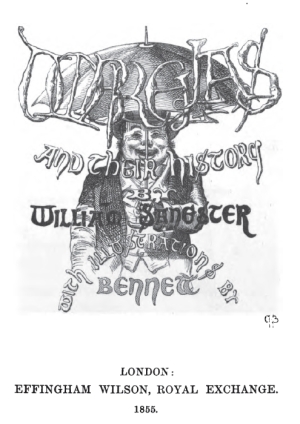Street View: 15, 3 Suppl., 7 Suppl. and 14 Suppl.
Addresses: 94 Fleet Street, 140 Fleet Street, 10 Royal Exchange
As early as 1786, one Samuel Sangster is mentioned as cane merchant of Fleet Street.(1) Whether he already occupied number 94 is not certain, but that particular address is mentioned as being in the family at least since 1802. In that year Samuel Sangster, dealer in sticks and canes, insured his business against fire.(2) Samuel also appears as stick and cane manufacturer in the list of members of the Society for the Encouragement of Arts, Manufactures, and Commerce “extended to December 31st, 1818”.
In an advertisement in Palmer’s European Pocket Guide of 1882, the Sangster firm claims to have been established in 1777 and although 94 Fleet Street is mentioned as one of their premises, it does not necessarily follow that it all started at no. 94. The Street View elevation shows the passage to The Old Bell between numbers 94 and 95. This pub was built by Christopher Wren for the builders working on St. Bride’s Church after the 1666 Fire. For centuries, the Fleet Street entrance to the pub was through this small alleyway, but nowadays the pub has taken over what was number 96 (In 1840 Hemsley’s Baby linen warehouse) and they have a proper front in Fleet street.
The 1882 advert also show the other addresses where Sangster could be found: 140 Regent Street, 10 Royal Exhange and 75 Cheapside. The 140 Regent Street address must have been acquired between the publication of Tallis’s first series of Street Views, when 140 was still occupied by R.H. Franks’ hat shop, and 1847 when the supplements were brought out.
Samuel’s cane shop developed into an umbrella and cane shop when his two sons, William and John, took over the shop. William was born on 3 Feb. 1808 and John on 24 Nov. 1811; they were both baptised in St. Bride’s Church.(3) At some point, however, the family moved to the ‘Paragon’, a newly developed housing estate in Streatham, Surrey where they are found in the 1841-1881 censuses. The brothers called one of their umbrellas ‘the paragon’.

For the ladies they developed parasols “for the fête, promenade, or sea-side”. According to London as it is Today the most important article among the stock of Sangster’s was their “Sylphide Parasol, light and graceful [… that] may now be seen in all the most fashionable drives and promenades in and about London”. The demand for this new fashion item was so great, that “the manufacturers have supplied no less than sixty thousand” of them. But one is not to forget that Sangster’s were also “the patentees of the much approved Alpaca Umbrella, of which upwards of seventy thousand have been sold”.
The British Museum has in its collection a draft for a trade card which also shows the Regent Street shopfront with the canes and umbrellas displayed in the window. The shop windows could be so large because the excise duty on glass had been repealed in 1845, which allowed for far larger display windows.
In the London Society Magazine of 1864. W. & J. Sangster announce “a large assortment of sun shades and parasols, made of entirely new patterns in Lyons silk, &c.” and lest you forget, they also remind you of the fact that they “have been awarded four prize medals for the quality of their silk and alpaca umbrellas”.

Advertisement in London Society Magazine July 1864 (thanks to Grace’s Guide)
In 1855, William even wrote a book about umbrellas, Umbrellas and Their History. The illustrations were by Charles Henry Bennett (1828-1867). You can read the whole book online here if you want, but I will just show some of the pictures.

William Sangster died 3 September 1888, his brother John a few years later on 17 November 1890. Their combined estates were valued at almost £83,000.
(1) PROB 11/1144/256. He was buried on 31 July, 1786 in St. Bride’s Church.
(2) Sun Fire Office, National Archives, MS 11936/424/727039.
(3) Baptism records St. Bride’s Church: William was baptised 10 August 1808; John 10 June 1812 at the same time as his sister who had been born 17 Nov. 1809. Their mother was Harriet Cockerell and some of the baptisms of Samuel and Harriet are accidentally listed under Cockerell.
Neighbours:
| <– 95 Fleet Street <– 142 Regent Street <– 9 Royal Exchange |
93 Fleet Street –>138 Regent Street –>11 Royal Exchange –> |














Had a kind email from Schirm Oertel, Bremen (www.european-umbrellas.com) with additional information about the ‘paragon’ which readers might find of interest:
“Thank you very much for your email and the “great” information. Something is new and some pictures are well known. The “paragon” is now the name for the u-profile of umbrella ribs in steel. They were first made in Sheffield by Fox. Everything in the umbrella world changed when in 1928 the folding umbrella started in Germany as an industrial product.”
Pingback: Five little-known inventors of the Victorian era - The National Archives blog